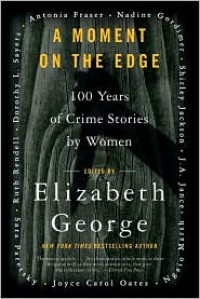A Moment on the Edge: 100 Years of Crime Stories by Women
 Author Elizabeth George, best known for her Inspector Lynley mysteries, selected 26 crime stories by women authors for the anthology A Moment on the Edge: 100 Years of Crime Stories by Women (2002). In her introduction, George analyzes how and why people have been fascinated with crime stories since ancient times and takes to task those critics of the genre who believe crime writing is a lesser form of literary endeavor. The stories George chose certainly make a strong argument for their inclusion in any anthology of quality short fiction, whether it's crime-themed or not.
Author Elizabeth George, best known for her Inspector Lynley mysteries, selected 26 crime stories by women authors for the anthology A Moment on the Edge: 100 Years of Crime Stories by Women (2002). In her introduction, George analyzes how and why people have been fascinated with crime stories since ancient times and takes to task those critics of the genre who believe crime writing is a lesser form of literary endeavor. The stories George chose certainly make a strong argument for their inclusion in any anthology of quality short fiction, whether it's crime-themed or not.The anthology arranges the stories chronologically, starting with the classic "A Jury of Her Peers" by Susan Glaspell from 1917. From there, the timeline progresses to stories by Golden Age mystery writers Dorothy L. Sayers and Ngaio Marsh, and then "New Golden Age" authors including Sara Paretsky and Marcia Muller. There are also selections by writers considered to lie outside the genre: Shirley Jackson, Nadine Gordiner, Antonia Fraser and Joyce Carol Oates. Each selection is prefaced with a description by George that includes a brief bio of the author and a tidbit or two about the story, as with "The Man Who Knew How" by Sayers, which was adapted for radio starring Charles Laughton and Hans Conreid.
All the sub-genres in crime fiction are well-represented, from the supernatural in "Death of a Snowbird" by J. A. Jance, where the spirit of a dead Native American girl appears in a retired couple's RV as they spend the winter in Arizona (1994); psychological suspense in "Afraid All the Time" by Nancy Pickard, following a woman who moves to the plains and descends into a nightmare (1989); a police procedural featuring Ngaio Marsh's Inspector Allyn in "I Can Find My Way Out" (1946); a "whydunnit" from Margery Allingham in "Money to Burn" (1957); the noirish "New Moon and Rattlesnakes" by Wendy Hornsby (1994); and even a Sherlock Holmes/Dr. Watson pastiche by Gillian Linscott ("A Scandal in Winter," from 1996).
George's intention was to have the stories illustrate how crime fiction, particularly that written by women about women, has changed in the last hundred years. This is likely one reason she bookends her choices with two tales about the death of abusive husbands, written 80 years apart (the authors' lives span 100 years, but not necessarily the stories). As Elizabeth George notes in her intro: "All of these authors share in common a desire to explore mankind in a moment on the edge. The edge equates to the crime committed. How the characters deal with the edge is the story."



